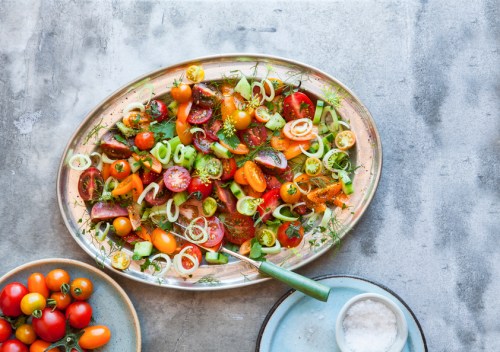Around nearly every corner of the health and wellness space is a reminder to increase your fiber intake—this makes sense, as most Americans aren’t getting nearly enough. And the industry has quickly sprung into action to help meet this demand with a whole slew of high-fiber food products.
Experts in This Article
registered dietitian
While fiber is a super healthy choice for many of us, there are some individuals who may need to avoid high-fiber foods for one reason or another. But does this mean these people can’t enjoy vegetables anymore? Absolutely not.
Ahead: Why some folks may need to opt for a low fiber lifestyle as well as what low fiber vegetables they can embrace—because, yes, they can still enjoy delicious vegetable-forward dishes.
Why some folks may need to opt for low fiber vegetables
To start from the beginning, fiber is a type of carbohydrate that can’t be fully digested by the body. Because of this, fiber often acts as “roughage” through the gastrointestinal (GI) tract, helping to promote digestion. Fiber also plays a number of other beneficial roles in the body, including feeding our gut microbiome flora, helping to lower cholesterol levels, and regulating blood sugar levels.
But there are some instances where fiber actually does more harm than good, usually due to the GI tract either undergoing some sort of stress or not functioning properly. Conditions that may require a low-fiber diet can include long-term ailments like irritable bowel syndrome (IBS), diverticulitis, or inflammatory bowel diseases (IBD) including Crohn’s disease and ulcerative colitis. A low-fiber diet may also be needed for short-term acute situations like a bad bout of the stomach bug, food poisoning, surgery involving the GI tract, GI-related cancers, side effects of cancer treatment, or prepping for a GI procedure like a colonoscopy.
This way of eating helps to effectively give the gut a rest as one of the effects of fiber (that many people are typically after) is that it stimulates and “works” the GI tract, helping to move food and waste through. However, in many of the cases mentioned above, this kind of gut activation can make matters worse. Usually when a healthcare professional recommends a low-fiber diet, they typically want the individual to consume no more than 10 grams of fiber per day (though this number can vary). This is a significant reduction compared to the general daily fiber recommendation of at least 25 to 30 grams for the average adult.
So: Does this mean veggies are out?
Given that vegetables are often the foods we turn to boost our fiber intake, those on a low fiber diet may think they can never enjoy a leafy green again. But this is far from the truth! There are so many options and cooking techniques that can help you continue to enjoy veggies.
When we think about where fiber is concentrated in both fruits and vegetables, oftentimes it’s in the skins and seeds—so removing those will automatically lower fiber content. Also, cooking starts to break down the cell walls of veggies, easing the digestive load on your body. Storage methods that yield a softer finished product, like canning and freezing, will also have this effect.
When we think about where fiber is concentrated in both fruits and vegetables, oftentimes it’s in the skins and seeds—so removing those will automatically lower fiber content. Also, cooking starts to break down the cell walls of veggies, easing the digestive load on your body.
10 low fiber vegetables for sensitive stomachs
Aside from these tips, there are veggies that are also lower in fiber compared to the rest. Most of these have less than three grams of fiber per serving and many can cook down to be really soft.
Potatoes
While potatoes are hardly considered a vegetable in certain health circles, these starchy favorites do indeed count. Plus, they are the perfect inclusion to a low fiber diet thanks to their relatively low fiber content. In fact, one medium white potato without skin contains about two grams of fiber.
Sweet potatoes measure up similarly in terms of fiber but will up the ante when it comes to vitamin and mineral content. Whether you enjoy them mashed, roasted, scalloped, or hasselback style, be sure to peel your potatoes to minimize the fiber content as much as possible.
Asparagus
A spring-time staple, asparagus is another great choice when aiming for low fiber options. This is not only due to the 1.5 grams of fiber found in half a cup, but asparagus also cooks to a soft consistency, increasing its digestibility. If you’re especially sensitive to fiber, opt for just the tops of asparagus spears as they will contain the least amount of fiber compared to the more woody stems. However, peeling the stems will help lower the fiber content here as well.
Squash
Both winter and summer squash varieties earn a spot on this list as they also cook down to a perfectly mushy consistency while containing a lower amount of fiber. Most types of winter squash including acorn, butternut, and spaghetti usually offer around three grams per half cup cooked. Whereas zucchini and yellow crookneck squash contain about two grams in the same amount. And while it’s commonplace to consume the skins and seeds of summer squash especially, be sure to remove them to lower the fiber content even more.
Spinach
Popeye’s favorite veggie is one of the few leafy greens you’ll see on this list, thanks to the mere 0.8 grams found in half a cup raw. Despite being so low in fiber, it’s still a good idea to cook this popular pasta, soup, and egg dish addition to help your body more easily digest it.
Tomatoes
Though technically a fruit, tomatoes are featured on this list as they’re effectively utilized as a veggie in most recipes. One raw medium tomato contains about one gram of fiber and that’s without the skin and seeds removed—though, again doing so is recommended and super easy to do. Plus, tomatoes are just one of the many low fiber fruit options to choose from.
Cucumber
Another fruit on this list is cucumber with a mere 0.5 grams of fiber per half cup. As if we weren’t sounding like a broken record already, definitely remove the skins and seeds when enjoying this crunchy snack time favorite as it can’t be cooked.
Carrots
Another great low-fiber snackable veggie is carrot. In one medium-sized carrot you’ll find about two grams of fiber. Peeled and cooked carrots can quickly turn into a delicious riff on mashed potatoes while also helping you to avoid any fiber-related tummy troubles.
Lettuce
Alongside cukes, lettuce is the other veggie found on this list that can be consumed raw, thanks to the 0.5 grams of fiber found in half a cup. If you’re newly adopting a low-fiber diet, however, I would start slow with raw options. Try small amounts at first and if that goes well you can cautiously increase the portion sizes from there.
Cold-pressed vegetable juice
Fresh, cold-pressed juices that you’d find from a juice bar or health foods store are also a great way to get your greens in without the huge fiber load. Though, while most of the roughage (insoluble fiber) will be removed in the juicing process, some of the soluble fiber will remain and can add up quickly when taking down a large bottle—so start slow here as well. I don’t generally recommend many of the veggie juices found at room temperature in grocery stores as they tend to contain secret ingredients like added sugar.
Canned Options
Finally, we have canned veggies, especially green beans and carrots. While fresh green beans are not optimal for a low fiber lifestyle, canned or boiled ones are—typically offering about two grams of fiber per half a cup. Canned green beans and carrots are not only convenient, but already softened for easy meal prep. However, some of these options will be higher in sodium, so if that’s a concern, either look for lower sodium varieties or simply give them a rinse prior to cooking.
While for most of us fiber is a good thing that we should actively be trying to include more of in our daily routine, it can also be a nutrient that some of us may need to be weary of. But a low fiber diet doesn’t mean you need to forgo veggies completely – just that you need to be savvy in your choices. With the information here, you can feel more equipped to make smarter low-fiber choices the next time you peruse the produce aisle.
Sign Up for Our Daily Newsletter
Get all the latest in wellness, trends, food, fitness, beauty, and more delivered right to your inbox.
Got it, you've been added to our email list.











